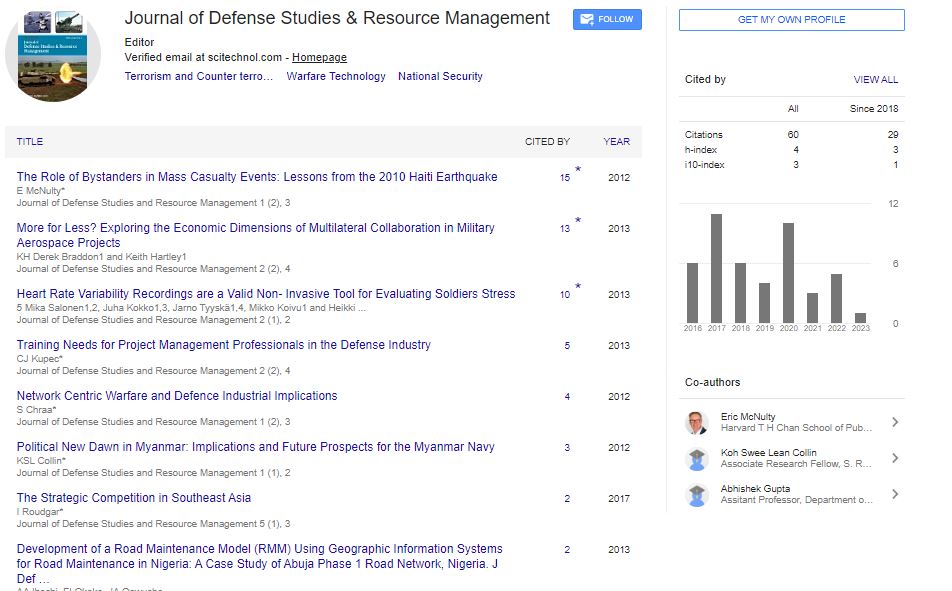Perspective, J Def Stud Resour Manage Vol: 11 Issue: 1
Defense Innovation and the Importance of Collaboration
Peter Ross*
1Department of the Center for Naval Warfare Studies, University of Kentucky, Lexington, USA
*Corresponding Author: Peter Ross
Department of the Center for Naval Warfare
Studies, University of Kentucky, Lexington, USA
E-mail: ross.pet@uk.edu
Received date: 28 February, 2023, Manuscript No. JDSRM-23-95540;
Editor assigned date: 03 March, 2023, Pre QC No. JDSRM-23-95540(PQ);
Reviewed date: 17 March, 2023, QC No. JDSRM-23-95540;
Revised date: 24 March, 2023, Manuscript No. JDSRM-23-95540(R);
Published date: 31 March, 2023, DOI: 10.4172/2324-9315.1000170
Citation: Ross P (2023) Defense Innovation and the Importance of Collaboration. J Def Stud Resour Manage 11:1.
Description
Defense innovation refers to the process of developing and implementing new technologies, capabilities, and strategies in order to enhance national security and defense. The defense industry is constantly evolving, with new threats emerging every day, and it is important to stay ahead of these threats by continuously innovating and improving.
Collaboration is key to achieving success in defense innovation. This is because no one individual or organization has all the knowledge, expertise, and resources required to develop and implement new defense technologies and strategies. By collaborating with other organizations, individuals, and government agencies, the defense industry can pool its resources, share its knowledge and expertise, and work together towards a common goal of enhancing national security and defense.
One of the most important reasons why collaboration is important in defense innovation is because of the complexity of the challenges facing the defense industry. Defense challenges are typically multifaceted and require expertise from a wide range of fields, including engineering, physics, computer science, and social sciences. By collaborating with experts from these different fields, the defense industry can develop more comprehensive and effective solutions.
Another reason why collaboration is important in defense innovation is that it can lead to more efficient use of resources. Developing new defense technologies and capabilities is a costly and time-consuming process. By working together, organizations can share the costs and resources required for research and development, which can help to speed up the innovation process and reduce costs.
Collaboration can also help to accelerate the implementation of new technologies and capabilities. The defense industry is heavily regulated, and it can be difficult to navigate the regulatory framework required to bring new technologies and capabilities to market. By collaborating with government agencies and other stakeholders, the defense industry can better understand the regulatory requirements and work together to streamline the process of getting new technologies and capabilities approved for use.
In addition to these practical benefits, collaboration can also lead to more innovative and creative solutions. When individuals from different backgrounds and organizations work together, they bring their unique perspectives and expertise to the table. This can lead to the development of new ideas that may not have been possible if individuals worked alone.
There are many examples of successful collaborations in defense innovation. One example is the Defense Advanced Research Projects Agency (DARPA), which is responsible for developing cutting-edge technologies for the US military. DARPA works closely with universities, research institutions, and private companies to develop new technologies in fields such as artificial intelligence, robotics, and cyber defense.
Another example of successful collaboration in defense innovation is the Joint Strike Fighter (JSF) program, which is developing a nextgeneration fighter aircraft for the US military. The JSF program is a collaboration between the US Air Force, Navy, and Marine Corps, as well as international partners such as the United Kingdom, Italy, and Australia. By working together, these organizations are developing a highly advanced and versatile fighter aircraft that can be used in a wide range of missions.
Defense innovation is important for enhancing national security and defense, and collaboration is key to achieving success in this field. By working together, the defense industry can pool its resources, share its knowledge and expertise, and develop more comprehensive and effective solutions to the complex challenges facing the industry. Collaboration can also lead to more efficient use of resources, faster implementation of new technologies and capabilities. Successful collaborations in defense innovative, such as DARPA and the JSF program, demonstrate the importance and benefits of working together towards a common goal.
 Spanish
Spanish  Chinese
Chinese  Russian
Russian  German
German  French
French  Japanese
Japanese  Portuguese
Portuguese  Hindi
Hindi 